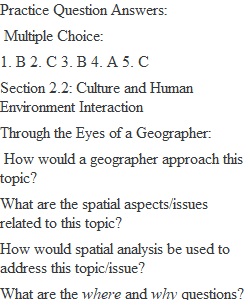


Q Section 2.2: Culture and Human Environment Interaction Through the Eyes of a Geographer: How would a geographer approach this topic? What are the spatial aspects/issues related to this topic? How would spatial analysis be used to address this topic/issue? What are the where and why questions? How can this topic be studied and analyzed using the five themes of geography? Overview: Culture determines what people believe and value, how they behave, and how they interact with the environment and each other. Within regions there is typically a dominant culture practiced by the majority, along with varying numbers of minority groups that express their own sub-cultures. Geographers are interested in the spatial variation of culture at all scales, and the resulting patterns on the landscape. Critical Thinking/Discussion Questions: 1. Is there an overall, dominant U. S. culture? What is this culture? Describe it. 2. Are there sub-cultural groups? Discuss these groups and give examples from the United States and other countries. Do you belong to a sub-culture? 3. How does culture affect who we are and what we do? How does it influence what we value and how we treat the environment and other people? What do Americans value? Practice Questions (Write Correct Answer in Blank): Multiple Choice: 1. ___ The Amish are an example of a U.S. sub-cultural group. This group migrated to the United States from: A) Holland B) Switzerland C) Belgium D) England 2. ___ This term is used to describe actions or processes that involve the entire world and result in making something worldwide in scope: A) universal B) Western C) globalization D) cultural uniformity 3. ___ With regard to resource consumption, most Americans feel a sense of: A) stewardship B) entitlement C) conservation D) uncertainty 4. ___ United States culture can best be viewed as a ____ culture: A) urban B) elderly C) rural D) middle-aged 5. ___ The largest percentage of the United States budget is spent on this category: A) transportation B) education C) military D) health True or False: 1. ___ Most Americans view themselves as a part of nature and want to preserve and protect the environment. 2. ___ Most Western societies place value on promoting the individual and individual lifestyle rather than the community and communal lifestyles. 3. ___ Arabs are not “new” immigrants to the United States, tracing their early origins to the 1870’s and 1880’s. 4. ___ Like all cultures, Amish culture has undergone dramatic changes in the past 200 years. 5. ___ Many Europeans felt they had a God-given right (Manifest Destiny) to settle the land and exploit natural resources in the “New World.”
View Related Questions